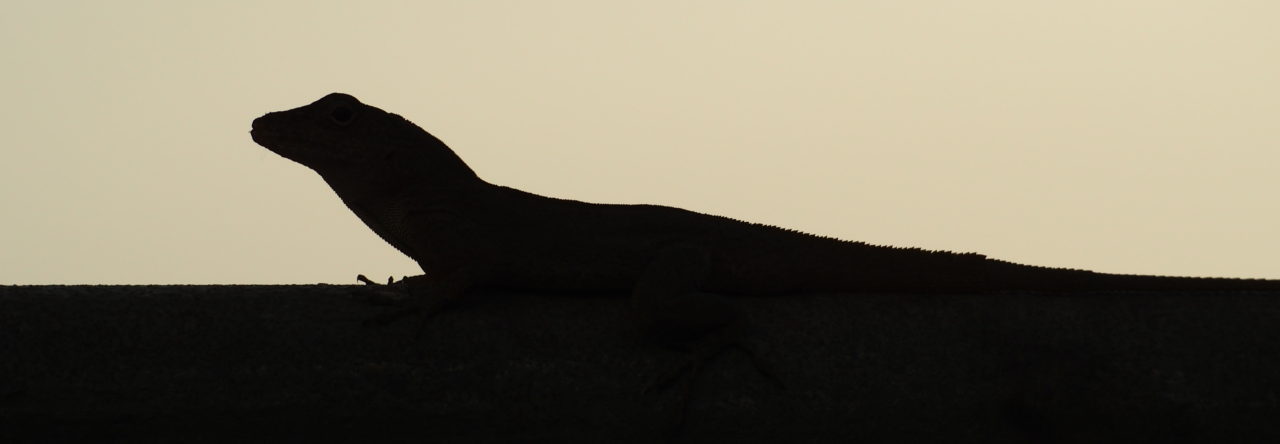Two male green anole lizards meet in the forest. One lizard has infringed on the territory of the other, who now feels threatened. In a bout of competition, the lizards extend their dewlaps, the flaps of skin beneath their lower jaw, and a faceoff ensues.
Observing this aggressive act, neuroscience major Maria Jaramillo ’17 pondered how the dewlap is processed as a stimulus in the lizards’ brains. She then compared this hostile social behavior with a non-social interaction, like a lizard’s observation of a leaf. How does the lizard’s brain handle each interaction? At what point and why is the brain more active?
To answer these questions, Jaramillo applied for and was awarded a $1,000 grant from Sigma Xi, The Scientific Research Society. The grant money will be used to purchase antibodies, used for immunocytochemistry, as well as other supplies like microscope slides. Jaramillo studies in the lab of biology professor Michele Johnson, a researcher of the evolution of lizard behavior, and collaborated with Johnson during the grant proposal.
“I find the brain very interesting because it controls everything that we do,” Jaramillo says. “I love to study lizards because the wild environments they live in provide all kinds of stimuli, and I want to understand how they process it all.”

For the study, Jaramillo recorded a video of a green anole lizard exposing its dewlap and edited the video, scrambling the pixels of the lizard but maintaining the exact same colors and movements. After removing the social context, Jaramillo analyzed a lizard’s reaction to the modified video in comparison to its reaction to the original. She also tested two lizards together and then played the video without the lizards as an additional control. The lizards were placed in arenas, and Jaramillo observed them using GoPro cameras.
Jaramillo was notified in December 2015 that she had received funding and couldn’t believe the news. She excitedly called Johnson to share her elation, as Jaramillo had been turned down for the grant during the previous application cycle.
“This was a super cool process because Dr. Johnson and I literally built this project together,” Jaramillo says. “I did a lot of the decision making and, even though lizards are not what I am going to study for the rest of my life, it has given me a lot of research experience where I have worked directly with a professor.”
Applying twice for the grant meant that Jaramillo and Johnson received feedback from Sigma Xi evaluators following the initial application. Jaramillo says she was not discouraged after being rejected, but eager to learn how best to improve her chances. A peer tutor for Johnson’s biology class, Jaramillo encourages other not to give up and to “just keep trying.”
From Katy, Texas, Jaramillo plans to pursue medical school after Trinity. Her motivation is to help others with their medical needs and keep them in good health. She says that she has always loved science, and views medicine as a rewarding way to put her interests to good use.
“Health is the thing everyone needs to survive,” Jaramillo says. “For someone who wants to go into medicine, understanding how to conduct research like this is critically important. Studying at Trinity has made me sure that I want to attend medical school and become a doctor.”
Carlos Anchondo is a writer and editor for University Marketing and Communications. He is a 2014 Trinity graduate and can be found on Twitter at @cjanchondo or at canchond@trinity.edu.





 The caption says: At first look this image may just look like an Amazon green anole (Anolis punctatus) climbing a tree; but look a little closer… there is a cryptically coloured cricket fooling the predatory eyes of the lizard.
The caption says: At first look this image may just look like an Amazon green anole (Anolis punctatus) climbing a tree; but look a little closer… there is a cryptically coloured cricket fooling the predatory eyes of the lizard. 

 I’m always amazed by the ability of anoles to survive–even prosper!–with dramatic injuries. How could a lizard get by missing half of a hind leg? How does it capture prey or escape predators? Display credibly? But they do.
I’m always amazed by the ability of anoles to survive–even prosper!–with dramatic injuries. How could a lizard get by missing half of a hind leg? How does it capture prey or escape predators? Display credibly? But they do. 



